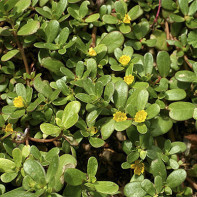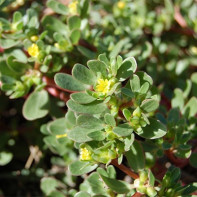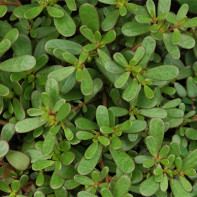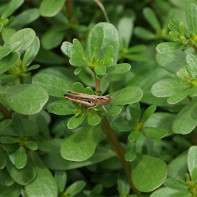Portulak garden: medicinal properties and contraindications
Out of almost 200 varieties and varieties of purslane, only one is used as a medicine in culinary and cosmetology - the garden one. The rest can simply be admired in the flowerbed or even grown in a flower pot on the home windowsill.
- Chemical composition
- How it looks and where it grows
- Collection and storage
- The healing properties of purslane
- Purslane garden in folk medicine
- For kidney treatment
- Infusion for men
- For the treatment of sexually transmitted diseases
- Leaves of a plant with insect bites
- With diabetes
- From hemorrhoids
- For the treatment of corns and warts
- For weight loss
- Seeds for the stomach
- Psoriasis Ointment
- Types of healing compounds
- Infusion
- Tincture
- Decoction
- Application in cosmetology
- Mask for the face
- Mask for normal to oily skin
- Mask for dry skin
- Hair lotion
- From oily seborrhea
- Face cream
- The use of purslane in cooking
- Purslane with sauce
- Scrambled Eggs with Purslane
- Vegetable salad
- Purslane Pesto Sauce
- Seasoning for meat
- Purslane and garlic appetizer
- Salad with parsley and purslane
- Sandwiches
- Light soup
- Pilaf with Purslane
- Contraindications
Chemical composition
Purslane is not widely used by traditional official medicine, however, biologists have well studied its chemical composition. They found that in the green, aboveground part of the plant contains proteins necessary for a person to develop muscles, improve the composition and appearance of the skin and hair, nails and skeleton.
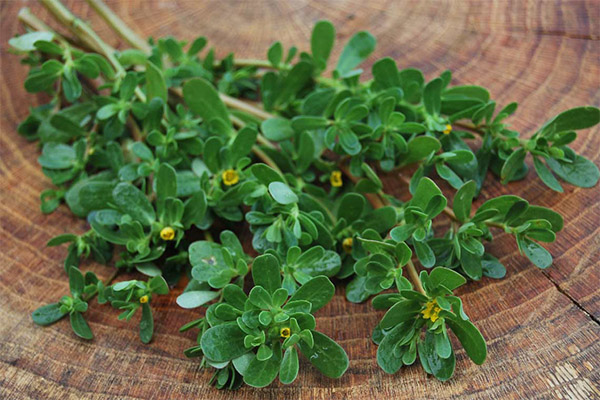
- The constituent plants are sugars, which are a source of energy for humans.
- Trace elements are represented in purslane by copper, zinc, nickel, manganese and iron.
- Macronutrients - potassium, calcium, sodium and magnesium.
All of them in microdoses are in the human body, and their absence or lack is immediately reflected in the deterioration of the cardiovascular, endocrine, reproductive and nervous systems, and a decrease in immunity.
- Organic acids contained in the plant are useful for the ability to maintain acid-base balance, and vitamins - tocopherol, carotene, ascorbic (C) and nicotinic acids (PP), phylloquinone (K1) - trigger the body's activity and fill it with energy.
- Purslane also contains alkaloids - dangerous substances, but in the treatment of a number of cardiac and oncological pathologies, diseases of the nervous and respiratory systems are necessary.
- Another group of substances in purslane is glycosides and related saponins, with which you need to be careful. They affect the functioning of the heart and are irritating.
- The greens contain tarry substances and mucus, which also have beneficial properties.
- Plant seeds are rich in oil, which, in turn, consists of fatty acids - such as oleic, linoleic, palmitic and others.
How it looks and where it grows
Purslane garden is an annual succulent. Its root system is pivotal, the main root grows into the ground to a depth of at least 20 cm, it is stocky, juicy, several lateral branches branch from it. Despite the external strength, the root is quite brittle, and the upper, aboveground part can easily come off. Since the plant is quite lively, in almost a day and a half, the broken off part already grows with new roots to the soil.
The stem of this herb is reddish in color and can reach a length of 10 to 30 and even 40 cm, and it is so smooth that it seems slightly polished. The stem branches from the very base and usually lies on the surface of the soil, therefore it is called lying. Its tops stretch to the sun and therefore rise up.
The leaves of the plant without stalks, they are located directly on the stem, their botanists are classified as sessile. As with all succulents, each leaf is juicy and fleshy, in shape or simple oval, or ovoid, or scapular.On the lower part of the stem, the leaves are attached alternately in a spiral, the upper - in pairs opposite each other.
Nondescript yellow small flowers are collected two or three in small bundles, sitting in inconspicuous places - either at the points of attachment of the leaves - in the sinuses, or in places where the stem branches. Purslane flowering period is from June to August.
After flowering, the plant forms fruitlets - small round or ovoid capsules no more than a centimeter in diameter, inside of which there are many small shiny black seeds. The boxes open across the crack, in different directions - like small collars. From this came the name of the plant, for "portula" in Latin means "small gate". The very fruit of the whole botany was given the name "wing". The fruits ripen in early autumn.
In the wild, purslane grows in the warmer regions of the Earth’s Northern Hemisphere. Some scientists are sure that his homeland is India, and from there he went to settle in other countries. In a warm climate, purslane is able to grow from a single root for several years, as it is a perennial. In the middle lane, it sharply slows down its growth with an autumn drop in air temperature, and it is not able to endure winter frosts categorically and does not survive even under additional shelter, which is why it is considered an annual growing from seeds annually.
Purslane is photophilous, likes sunny places, but at the same time wet. Prefers sandy soil. It is easy to meet him along streams and rivers, around ponds and quarries, gardeners must have met him in their plots, in gardens. And many summer residents who are aware of the beneficial properties of purslane, specially cultivate it in their area, planting it on solar beds with well-drained, richly seasoned organic soil. After cutting green shoots, new ones grow quite quickly, so in one summer season it is quite possible to get up to six to seven green mass harvests.
Collection and storage
Traditional healers use the green, aerial part of the plant. Harvested during flowering, it was during this period that the purslane is richest in nutrients.
You can cut the shoots near the ground itself, but only young and springy branches can be taken into the blanks. Old shoots begin to rot quickly during drying.
Since portulaca stems mostly lie on the ground, they are dirty, dusty, after cutting they must be washed with running water: first warm, then lower the temperature and bring to cool. After washing, spread the greens on a towel so that the glass water, and then tie in small bunches and hang them on the street, in the shade - so that it does not get rain if it suddenly goes.
After drying, put the purslane in cotton bags and store in a dry and cool room. In such conditions, it does not lose useful properties and a half years.
The seeds of a medicinal plant are harvested closer to the end of September, when they are already ripe. The grass is mowed, threshed, and the seeds are dried in domestic dryers, the temperature is set no higher than 50 degrees. If the autumn is warm, the weather is sunny, you can also dry the seeds in the fresh air - where they will not be exposed to direct sunlight. Seeds retain their beneficial qualities longer than grass - up to two years.
- To use purslane for culinary purposes, it is harvested either by pickling, or by salting.
- For pickling, the collected grass is washed and dipped in boiling water for 5 minutes. After that, it is placed in glass jars. For the marinade, pour 2 tablespoons of salt into a liter of water, a spoonful of sugar and spices - pepper, parsley, dill, bay leaf, garlic, basil. A large spoon of vinegar is poured into the boiled composition, immediately it is poured into cans with a purslane and they are sealed with their caps.
- For salting, you can use both the brine method and the dry method.
- For the brine method, the washed purslane is cut into pieces, boiled until soft and laid out in jars. The brine is prepared at the rate of half a tablespoon of salt per glass of water.The composition is boiled, filled with a purslane and rolled up with lids.
- For dry salting, cut 1 kg of the plant and mix it with 200 g of salt until it dissolves. Lay out the greens in jars and close with plastic lids, store in the cellar. Rinse before use to remove excess salt.
The healing properties of purslane
Purslane was used as a healing plant in the time of Hippocrates. Ancient Roman and Arab doctors and scientists described its properties. Even then, they not only healed the weak, but used it to restore beauty.
As ancient healers believed, it is possible to cleanse the body with its seeds, and heal the wounds with leaves and save those who were bitten by a snake or a poisonous insect. Treated with this medicinal plant vitamin deficiency, scurvy, stopped diarrhea with dysentery.
To this day, traditional medicine considers portulak one of the most valuable medicinal plants. It is still, as in ancient Greek times, used as an anti-inflammatory and wound healing agent. It is characterized by antitoxic and hemostatic abilities, as well as diuretic, vasodilating, analgesic effects. The diuretic effect is still considered one of the mildest, but effective among medicinal plants with similar abilities, therefore it is indicated for kidney diseases, especially if they are associated with impaired urine formation. It is also used to treat heavily healing, decaying wounds, ulcers. In addition, purslane is famous as an excellent restorative remedy.
- A medicinal plant is shown to those who suffer from low blood pressure, because even with a single dose it can raise blood pressure, and a course of treatment can completely get rid of the problem.
- Purslane also has a unique ability to lower blood glucose by increasing the rate of its breakdown, which is used to treat mild forms of diabetes. The grass is able to improve the well-being of the patient a few days after the start of taking medicinal formulations based on it, especially in elderly patients.
- Herbalists recommend purslane also to those who have heart failure. It stimulates the heart muscle and contributes to the normalization and fullness of the pulse.
- For the stronger sex, a healing plant helps to solve several delicate problems at once. Purslane-based products restore male power and relieve impotence, activate sperm production, and increase its quality. As a result, in men undergoing treatment for infertility with Purslane, the number of sperm cells increases, and their activity increases.
- As part of the complex therapy of sexually transmitted diseases, purslane plays the role of a stimulator of the body's immune forces, reduces treatment time and brings recovery closer.
- Since Purslane is able to affect the central nervous system, relieve causeless anxiety and improve mood, it has been successfully used to treat depression, insomnia and other disorders of the nervous system. Remedies from a medicinal plant improve mood and quality of life.
As a tool for treating disorders in the intestines, Purslane copes well not only with diarrhea, but also relieves internal bleeding. One of the important properties of the plant is its antibacterial effect on the causative agents of dysentery - Shigella and Salmonella bacteria. Therefore, it can not only protect against these intestinal infections, but also cures them.
It is also used as an anthelmintic. And thanks to the presence of vitamin A and beta-carotene in the plant — the substances necessary to maintain vision in order — regular consumption of purslane can be a cataract prevention tool.
Purslane garden in folk medicine
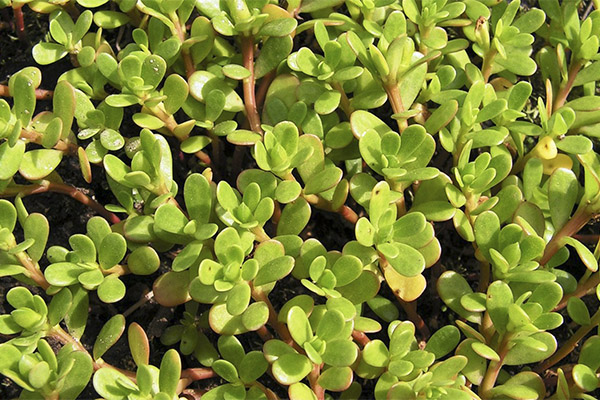
For kidney treatment
Freshly cut purslane is washed, cut into pieces and passed through a meat grinder. After which juice is squeezed out of the resulting slurry.They store juice in the refrigerator, drink 3 times a day before breakfast, lunch and dinner. Treatment is continued until complete cure, usually it takes at least two weeks.
Infusion for men
To prepare the remedy for impotence and infertility, a tablespoon of dry raw material is poured with a glass of boiling water, covered with a lid and insisted for two hours. Then the product is filtered and drunk four times a day for 2 tablespoons. The course of treatment is designed for at least 21 days.
For the treatment of sexually transmitted diseases
This tool can be included in the complex treatment of a sexually transmitted disease. Take 50 g of dry purslane grass and fill it with 250 ml of boiled water, while it should be warm. After 2 hours, the product is filtered, the gruel is squeezed. 2 egg whites are added to the liquid and mixed well. Drink during the day, dividing equally into several servings. Treatment lasts 10 days.
Leaves of a plant with insect bites
In order to get rid of edema and pain, especially after bites of wasps and bees, fresh portulaca leaves are used. Several leaves of the plant are washed with clean water, knead a little in the hands and applied to the affected area. Usually, one procedure is enough to eliminate unpleasant symptoms. If necessary, the leaves are applied up to 5 times a day.
With diabetes
For 400 ml of boiling water, you need 2 tablespoons of chopped herbs. Raw materials are poured with water and left overnight. The filtered product is drunk three times a day after meals, a single dose is 3-4 tablespoons.
From hemorrhoids
Purslane enemas are recommended as an additional tool to the therapy prescribed by the doctor. To prepare an enema, you need 2 tablespoons of warm water and freshly squeezed juice of a medicinal plant. Make such an enema in the morning and evening. For a good result, treatment is continued for two weeks.
For the treatment of corns and warts
Purslane greens are passed through a meat grinder, the resulting slurry is applied to the corn or wart, securing it with adhesive plaster. This is an option without a bandage. And you can put gruel on the bandage and attach it to the problem place.
For weight loss
Throw a tablespoon of finely chopped herbs into a mug of boiling water, boil for another 5 minutes over low heat. Remove from heat, pour into a thermos, close it tightly and leave for an hour and a half or two. Then the broth is filtered and drunk a quarter of an hour before meals 3 times a day. Norma - a tablespoon at the reception. This composition is also useful as a means of alleviating the condition in diseased joints.
Seeds for the stomach
This tool helps not only with stomach problems, but also as an antipyretic and pustular skin diseases. To prepare it, pour a teaspoon of the seeds of the plant into a glass of boiling water and boil for about 2-3 minutes. The resulting broth is divided into 3 times and drunk throughout the day for 3 doses.
Psoriasis Ointment
Purslane seeds (a teaspoon) are ground in a mortar into a powder, mixed with petroleum jelly or any fat (tablespoon). They rub the healing composition into the skin with psoriasis and are also used to treat tumors on the skin. At the same time, a decoction of the seeds of the plant is taken orally.
Types of healing compounds
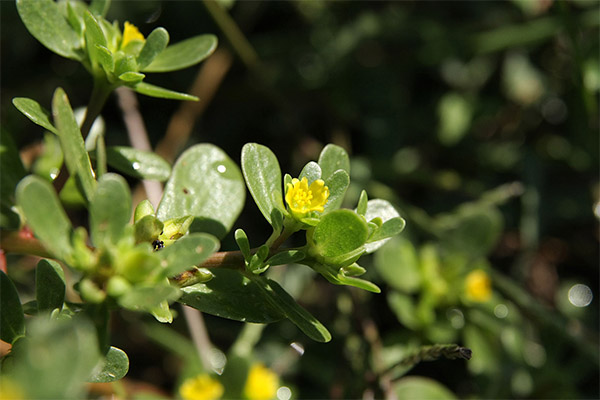
Infusion
For external use, purslane infusion is recommended for the preparation of a compress or lotion for depriving, psoriasis or various skin ulcers. Inside it is used for problems with the gastrointestinal tract - for example, for the treatment of ulcers, various digestive disorders.
To prepare the infusion, crushed grass (a tablespoon) is poured into a glass of boiling water. Insist composition for 1.5 hours. Inside, take 2 tablespoons 4 to 5 times a day.
Tincture
Purslane tincture is a universal remedy. It can be used both for insomnia and for diseases of the liver or kidneys, as well as for other ailments. The standard dose is 30 drops of tincture 3 times a day.
For 200 ml of alcohol, take a tablespoon of crushed portulaca raw materials, put everything in a bottle of dark glass, tightly cover it and insist for 3 weeks out of the reach of daylight and sunlight. At the same time, the contents of the bottle are shaken daily. After 21 days, the tincture is filtered and stored in a cool dark place.
Decoction
Purslane decoction is good as a diuretic and choleretic agent. They cleanse the liver, men treat impotence, women get rid of hormonal disruptions. As an external remedy, the decoction is recommended for the treatment of complex difficult to heal purulent wounds and other skin problems.
To prepare a decoction, pour a glass of boiling water into a ladle and pour a tablespoon of the chopped medicinal plant into it. The ladle is put on a small fire and the composition is heated for 10 minutes. Remove from the stove, wrap in a blanket and insist a couple more hours. Filter and take inside 2 tablespoons 5 times a day.
Application in cosmetology
For cosmetic purposes, the anti-inflammatory, soothing, antimicrobial, antifungal and antipruritic properties of purslane, as well as the ability to relieve allergy manifestations, are used, therefore, its agents are used for therapeutic purposes.
In addition, cosmetologists noted that purslane helps moisturize and soften over-dried skin, and also, thanks to the antioxidant activity based on the presence of a natural antioxidant glutathione and vitamin C in the plant, rejuvenates it, smoothes wrinkles and prevents the appearance of new ones, which allows the plant to be included in complex anti-aging programs.
Purslane can also be used to eliminate skin irritations, redness, itching, and to treat skin inflammations such as rosacea and acne.
Also, the grass is used as a hair care product, after several procedures they stop breaking and falling out, begin to look much more healthy, dandruff disappears.
Mask for the face
Recommended if the skin is dry, sensitive or irritated.
To prepare such a composition, 2-3 tablespoons of the grass broken with a blender are mixed with cottage cheese or sour cream, taken in the same amount. A thick layer of the mask is applied to the face and neck and left for 15-20 minutes. It’s better to lie down quietly to allow the mass to soak in well. Then wash with water or chamomile broth, heated to 38-40 degrees, and apply any nourishing cream.
The systematic use of the mask (approximately once every 7-10 days) smoothes wrinkles, removes peeling of the skin, eliminates various rashes and inflammations.
Mask for normal to oily skin
Meat grinder or blender turn portulaca into porridge. Take 2 tablespoons of the mass and mix it with the teaspoon left after breakfast, cooked in water or oatmeal milk. Apply a mask to the skin for a quarter of an hour, and then wash it with cool water.
Mask for dry skin
Purslane greens are crushed with a blender or meat grinder to a state of gruel. Take 2 tablespoons of the resulting mass, add a teaspoon of honey to it and carefully, dropwise, the vegetable oil - to such a state that the finished product does not spread. Apply it to the skin for 15-20 minutes. Remove the composition with a cotton pad soaked in warm tea leaves of green tea, then rinse your face with cool water.
Hair lotion
To prepare a healing composition, pour 2 tablespoons of chopped grass into a glass of boiled water. Insist the product for 50-60 minutes, after which it is used to rinse the hair roots and rub into the scalp. The composition is not washed off.
Thanks to the regular use of the lotion, the hair follicles are strengthened, dandruff disappears, the hair structure improves, they become shiny.
From oily seborrhea
To combat dandruff and oily seborrhea, a tablespoon of chopped purslane is poured into a small glass (200 ml) of water and boiled for 10 minutes. Insist for three hours, after which they are diluted in ordinary water to the volume necessary for rinsing.
Face cream
Drop 1-2 drops of juice squeezed from purslane into a serving of cream, which is usually used for morning or night care. This will additionally nourish the skin with useful substances and improve the action of the usual cream.
The use of purslane in cooking
Purslane began to be used as food in enlightened Europe in the 17th century. The Frenchmen were the first to “figure it out”, and after them, and in all other states, they began to prepare delicious dishes from a fashionable plant.
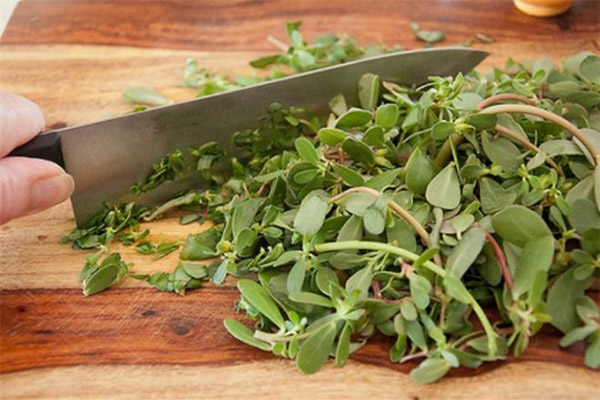
Due to the presence of sugars and proteins in the composition, purslane becomes especially nutritious, and these substances useful to the body are contained in the form of easily digestible compounds. And this is not a discovery for Russian culinary, the recipe for canned purslane is even recorded in the famous and legendary “Book about tasty and healthy food”.
Young herbs are used in cooking raw and boiled. Young leaves and tender juicy stems are pleasant, stimulate appetite, are able to quench thirst, they are even used to insist on a vitamin drink. Purslane is not only popular with residents of Central Asia, the Caucasus and the Mediterranean countries, but also loved. Delicious soups and salads are obtained from the plant, mashed from them, put into meat dishes as seasoning, and the resulting dishes acquire a pleasant, slightly spicy taste with a slight acidity. Salted or pickled winter purslane even replace capers. The plant is in good harmony with meat, fish, eggs, cottage cheese and vegetables, with the exception of potatoes.
Before starting cooking, purslane should be washed thoroughly to remove sand and insects from the axils of the leaves.
Purslane with sauce
To prepare this dish, cook 250 g of purslane, peel 1-2 medium-sized carrots, an average onion, a glass of tomato juice, a bunch of parsley and dill. Add salt and sugar to your liking.
Rinse the purslane thoroughly, cut into small pieces and cook for 2-3 minutes in salted water. Fry grated carrots and finely chopped onions in a frying pan in favorite pan, add tomato juice and chopped dill with parsley. Simmer for 5 minutes. The resulting sauce pour boiled purslane. Serve hot to the table.
Scrambled Eggs with Purslane
Cut a bunch of purslane into pieces no more than 2 cm, medium-sized tomato - with rings. Fry the purslane in sunflower oil, until it turns golden, put the tomatoes there. Beat 4 eggs in a bowl with 2 tablespoons of mayonnaise or sour cream, salt, pepper, pour this mixture into a frying pan with purslane and tomatoes, cover and simmer for 10 minutes over low heat. When serving, put arugula in a plate with fried eggs, chop fresh cucumber and tomatoes, sprinkle the dish with chopped herbs - you can use dill, basil, parsley, cilantro.
Vegetable salad
Pick 2 cups of purslane leaves, rinse them and let the water drain. If the leaves are large, they can be cut, small - leave intact. Cut large tomato, red onion into rings and chop 2 hard-boiled eggs into cubes. Put prepared foods in a salad bowl, add half a cup of canned corn to it, salt (preferably with sea salt), pepper and pour with vegetable oil - the one that is usually used for salads - sunflower, olive, mustard or nut.Serve immediately after cooking.
Purslane Pesto Sauce
Beat 450-500 g of fresh young green purslane (leaves and shoots) in a bowl of a food processor with two cloves of garlic, an incomplete cup of grated hard cheese - better than parmesan, a quarter cup of fried almonds. At the end of the procedure, pour half a cup of olive oil (unrefined) in a thin stream and turn off the combine after 15–20 seconds. Transfer the sauce to glass or porcelain dishes and put in the refrigerator, where it can be stored for up to two weeks.
Seasoning for meat
Rinse well and boil 100 g of purslane. Grind it in a blender, adding garlic (4 to 6 cloves), ground pepper and a large spoon of vinegar during the grinding process. To salt. Keep the prepared seasoning in the refrigerator for no more than a crescent, serve with hot and cold meat products.
Purslane and garlic appetizer
It is necessary to take equally - 500 g each - purslane and garlic shooters. You will also need one large carrot and onion, and vegetable oil for frying.
Cut the onion into half rings and lay out for roasting in a hot pan. Put the carrots, shabby in long strips with a Korean carrot grater, into the fried onions.
Purslane and garlic arrows cut into 3-4 cm slices and send into the same pan. Salt, pepper and fry vegetables until golden brown. To make the appetizer more satisfying, add minced meat to it. With minced meat, the dish is served on the table only hot, without minced meat - it can also be cold, this does not impair taste. If you use it in this form, you can add mayonnaise.
Salad with parsley and purslane
For 400 g of portulaca, take 2 bunches of parsley and the same amount of cherry tomatoes. If the tomatoes are large, cut them in half. Purslane cut into 3-4 cm slices, parsley - finely, add medium-sized onion, sliced in half rings. Fold the vegetables in a deep salad bowl, mix, pepper, salt, pour a tablespoon of freshly squeezed lemon juice and 3 tablespoons of vegetable oil (preferably olive).
Sandwiches
Purslane stalks lower for a couple of minutes in boiling water. Remove, squeeze with a paper towel and chop finely. You can sprinkle with purslane any sandwiches - with cheese, fish, butter, add chopped parsley, garlic, dill, celery.
Light soup
Pass 2 cloves of garlic through a garlic squeezer and cut the middle onion. Fry them in a frying pan in any vegetable oil, then add 2 small tomatoes, cut into cubes, to them. Put out all together. Rinse and cut a bunch of purslane, add to the pan and put a cup of lentils in the same place. Add water so that it is at least two fingers above the level of the contents. If during the cooking process the water leaves, you can add boiled water. Salt the dish to taste and cook until lentils are ready.
Pilaf with Purslane
Pour half a glass of rice with a glass of water and simmer over low heat. At the same time finely chop the onion and fry in a pan in vegetable oil until golden brown. Add to the pan a tablespoon of tomato paste and 150-200 g of purslane, cut into pieces from 1 to 1.5 cm.
When the rice is cooked, put in it a mass of fried in a pan, salt and add 2-3 tablespoons of sour cream or unsweetened yogurt.
Contraindications
Although Purslane is good for health, as with any product, there is no need to overdo it. The permissible daily norm of the plant is 200 g, it is not worth eating anymore.
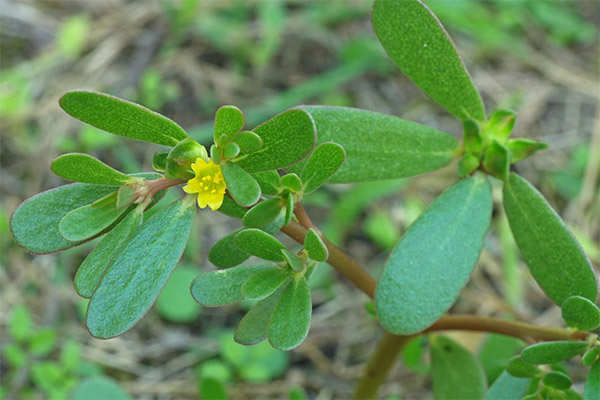
Nursing mothers with the use of plants are worth the time. A baby will be born and grow up - you can eat for your own pleasure! Pregnant women will also have to delay the application of purslane. The fact is that it is able to increase the tone of the uterus, and the consequences of this can be very deplorable.
The plant is contraindicated for people suffering from hypertension and bouts of bradycardia. Care must be with him in a state of strong nervous tension. You cannot eat purslane and treat it to those who are prone to convulsive seizures.
Since norepinephrine is located in the aerial part of the purslane - a substance similar to the hormones formed in the human adrenal glands, its action boosts the nervous system and increases overall tone, adds energy. And this applies not only to sick people, but also to healthy ones. But with increased excitability, the purslane will render poor service. Overexcitability and nervous exhaustion are possible, therefore its use is undesirable.
In addition, everyone, even the most healthy person, can have an allergic reaction to the components of the plant.
«Important: all information on the site is provided exclusively in fact-finding purposes. Before applying any recommendations, consult with a profile specialist. Neither the editors nor the authors are liable for any possible harm caused materials. "

